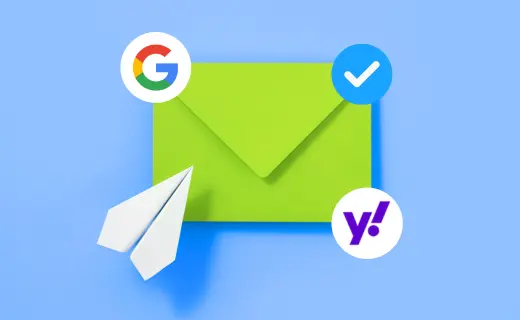Help article
Your guide to email authentication for Google and Yahoo requirements

We’ve prepared a simple guide for compliance with Google and Yahoo requirements. If you are sending emails to Google and Yahoo in 2026, you must follow the new rules below.
What are the new rules exactly for Google and Yahoo?
Google and Yahoo now require email authentication from all users sending bulk emails to their network. Whether you’re sending marketing emails, transactional emails, or sales emails, you must ensure compliance to avoid your emails being blocked.
Here is a quick summary of the new rules.
1. Email authentication is a must (SPF, DKIM, and DMARC records; you can use the free tools provided by EmailGuard to help you generate these records).
2. Spam complaint rate must be under 0.3% (ensure that you are sending emails to people who want to receive them).
3. Adding one-click unsubscribe links in your emails.

4. Ensure that your sending servers respond to DNS (valid reverse DNS PTR records) requests (if you are using popular email platforms, then you are already covered).
5. Ensure that you use a TLS / SSL connection for outbound emails (most email providers already support this by default).
The most common tweaks you need to make are: email authentication with SPF, DKIM, and DMARC, one-click unsubscribe links, and a low spam rate (under 0.3%).
How are you affected if you are sending emails to Google and Yahoo?
If you are not following the latest rules, your emails will start to get blocked. You will receive automated messages from your email providers notifying you that your emails are failing to deliver.
Error code 550 is a common error code that is automatically sent to your outgoing inboxes.
How can you get your emails delivered to Google and Yahoo?
In order to get your emails delivered to Google and Yahoo inboxes, you need to be compliant with their new rules. This means that you must implement the following:
1. Ensure valid SPF, DKIM, and DMARC records for your sending domains.
2. We recommend splitting up your email traffic for different emailing purposes. For example, business emails go through domain.com, transactional emails go through getdomain.com, and marketing emails go through trydomain.com.
3. Ensure that you include one-click unsubscribe links in your bulks sending emails. Most email providers, like MailChimp and SendGrid, provide this automatically. If you are using a cold emailing platform, we recommend adding an easy way to opt-out as well.
4. Maintain a low spam rate. We recommend double verifying contacts when they sign up for your email lists (e.g. send them a confirmation email). Using contact verification tools can help you clean up your email list.
5. Use popular sending platforms that already adhere to reverse DNS rules and TLS connections. If you have a custom emailing setup, you can share this article with your technical team to make them aware of these rules as well.
Why should you use EmailGuard if you are sending emails to Google and Yahoo?
With EmailGuard, you get complete monitoring and compliance for all your email sending needs. Since Google and Yahoo want your emails to be authenticated (valid SPF, DKIM, and DMARC) records, EmailGuard can help you generate and monitor your records.
EmailGuard will also automatically monitor your domains and connected email accounts against well known blacklists. This way, you can be sure that your domains or email accounts (sending servers) are not being preemptively blocked.
If you are blacklisted, you can request blacklist providers to unlist your domain or sending IPs, or if you are using multiple secondary domains, you can opt for a dedicated Hosted Domain Redirect. This will ensure that your secondary domain traffic is filtered and passes through a clean IP network.
EmailGuard also provides you with built-in contact verification. Before sending out any bulk emails, whether it’s email marketing or sales emails, you will want to make sure that your contacts are valid. Simply upload your list to EmailGuard and let us tell you which contacts are actually valid.
Everything you need to power up your email game in one place.
Start now for free. No credit card required.
